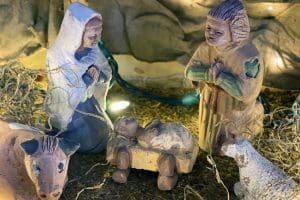![]()
Quetzalcoatl
By Daniel C. Peterson and William J. Hamblin
Perhaps the most important god in ancient Mesoamerican mythology – as well as the most complex and difficult to understand – is Quetzalcoatl. When trying to appreciate the role of this god in Pre-Columbian Mesoamerica, it is vital, first, to distinguish between the mythic god and the legendary Toltec priest Topiltzin Quetzalcoatl, and, second, to pay careful attention to the dates and locations of the various elements of the mythology.
The Aztec name Quetzalcoatl means “quetzal-feathered serpent,” referring to the quetzal bird’s beautiful blue and green plumage. In Maya dialects, he is known as Kukulcan. Archaeological evidence exists for the worship of Quetzalcoatl from at least the first century AD in Teotihuacan, the massive urban center and temple-complex near modern Mexico City. Iconographic elements of his cult can be traced back even further. But the veneration of Quetzalcoatl rises to its greatest significance after 900 AD among the Toltecs of Tollan (Tula), the post-Classical Maya of the Yucatan, and the Aztecs.
We must keep in mind, however, that the most important surviving written sources for the legends of Quetzalcoatl derive from sixteenth-century (i.e., post-conquest) Spanish translations and descriptions of Aztec history, religion, literature, and legends. It is uncertain how far back in time many elements of the Quetzalcoatl legends can be traced, or how accurately the Spanish understood and recorded them.
Mythologically, Quetzalcoatl plays an important role in both the creation of the universe and the invention of culture, including the discovery of agriculture, science, the arts, and fire. He is frequently worshiped as the patron god of science and learning. In mythic times he participated in a primordial sacrifice, in which he descended into the underworld, outwitted the god of the dead Mictlantecuhtli, and rescued mankind from the power of death. Thereafter he ascended into heaven, where he became the evening-and-morning star Venus (in Aztec, Tlahuizcalpantecuhtli). Temples dedicated to Quetzalcoatl were often centrally placed in Mesoamerican cities, and his rites were closely associated with the astronomical phases of Venus.
Aztec legends also record the story of the semi-divine priest-king Topiltzin (“Our Young Prince”) Quetzalcoatl, who ruled over the golden age at the paradisiacal city of Tollan. Although the Aztecs associated their legendary Tollan with the eleventh century ruins of the Toltec city Tollan, where the cult of Quetzalcoatl was especially important, the Tollan of Quetzalcoatl is best viewed as a primordial mythic city. Quetzalcoatl is said to have had a cosmic vision of the high-god Ometeotl, and to have governed by his authority. Under his rule, Tollan was the center of ceremonial order, righteousness, abundance and wealth, social harmony, and artistic brilliance.
Human sacrifice was forbidden by Quetzalcoatl, who ruled with mercy and justice. As the perfect priest-king, Topiltzin Quetzalcoatl provided the prototype for subsequent Mesoamerican leaders, legitimizing the social, religious, and political order of kings and priests claiming to rule after him and by his authority. Indeed, Aztec high priests were called Quetzalcoatl.
This perfect order was destroyed, however, by the intervention of the demonic Tezcatlipoca (“Smoking Mirror”), who, by the power of a magic obsidian mirror, tricked Quetzalcoatl into betraying his priestly vows. Tezcatlipoca thereupon usurped authority, demanding human sacrifice, and the golden age disintegrated. The story has two different endings. In the first, Quetzalcoatl sacrifices himself on a funeral pyre, ascending into heaven to become the star Venus. In the second, he sails off into the sea, promising to return one day, overthrow Tezcatlipoca, and restore his perfect kingdom.
The myth of the return of Quetzalcoatl played an important role in the subsequent history of Mesoamerica. When Cortes and the Conquistadors arrived in Mexico in 1517, the Aztec king Moctezuma II was convinced that the Spaniard was Quetzalcoatl, returning as he had promised. Accordingly, Moctezuma sent great treasures to Cortes, inviting him to assume rule of the kingdom. Spanish cruelty and treachery soon disabused the Aztecs of their confusion but, by then, the Conquistadors were well established and had raised thousands of allies from the disgruntled Native American vassals of the Aztecs. The conquest of Mexico was thus in part stimulated by the perfect faith of the Aztecs that Quetzalcoatl would one day return as promised.
There are a number of important recent studies on Quetzalcoatl:
- Neil Baldwin, Legends of the Plumed Serpent: Biography of a Mexican God (1998). This is a somewhat novelistic retelling of the myth.
- Burr Cartwright Brundage, The Phoenix of the Western World: Quetzalcoatl and the Sky Religion (University of Oklahoma Press, 1985).
- David Carrasco, Quetzalcoatl and the Irony of Empire: Myths and Prophecies in the Aztec Tradition (University of Chicago Press, 1982).
- Enrique Florescano, The Myth of Quetzalcoatl (Johns Hopkins University Press, 1999).
- H. B. Nicholson, Topiltzin Quetzalcoatl: The Once and Future Lord of the Toltecs (University Press of Colorado, 2000).
From the Latter-day Saint perspective, a brief discussion, with references to additional bibliography, can be found in John L. Sorenson, Images of Ancient America: Visualizing Book of Mormon Life (Provo, UT: FARMS, 1998), 206-207. An interesting web page by Brant Gardner can be found at: https://www.nmia.com/~nahualli/Quetzalcoatl.htm .

















